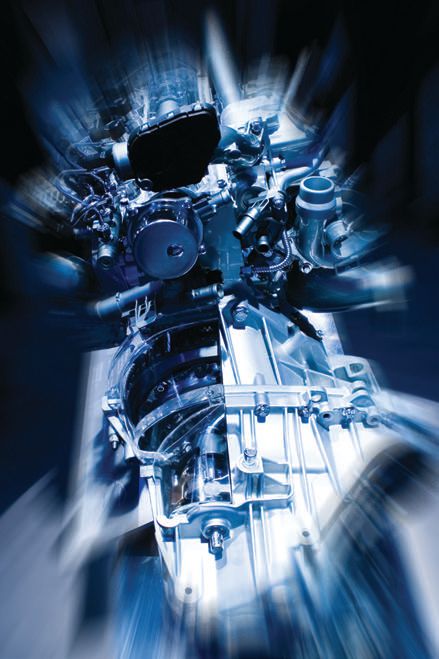What attributes make a new technology a “game changer?”
TLT Sounding Board June 2012

www.canstockphoto.com
Want to make a lot of money real fast? According to our readers, here’s the formula for a game-changing new lubricant. Create a product offering a lubrication property previously unobtainable. Make sure it can be used on existing equipment with no modifications. The lube should be easy-to-use, cost-effective (in a way that’s measurable), sustainable and safe for the environment. Above all, the lube should deliver performance that tops all competitors. Toss in an award-winning marketing/advertising campaign, and you’ve just taken your first step toward becoming a multimillionaire. When we asked our readers about the most important game-changers to impact the lubricant marketplace in the last 50 years, synthetic basestocks, additives, nanotribology and VI improvers topped the list. Asked about future game-changers, a majority of readers said they’d come equally from basestocks and additives.
Must be significantly better or a totally new alternative.
The refining of Group III basestocks has changed the game of formulating full synthetic engine oils. The qualities and attributes are cleaner engines, longer drain intervals and cleaner emissions.
Efficiency, cost effectiveness, uncomplicated, environmentally friendly.
Discovery.
Will it reduce energy requirements? Will it reduce equipment-related issues? Will it reduce lubricant cost overall?
One attribute must be that the new technology work within the framework of the old technology. In other words, no major refitting of equipment for the new technology to operate.
Timing with political and environmental developments.
The benefit it will provide as it pertains to the application. This could be extended drain intervals, longer performance characteristics or many other attributes as it relates to our fluid industry.
Significantly improved performance without increased price.
Any new technology that makes lots of current technologies obsolete, costly or inefficient is a game changer.
(1.) Affordable, (2.) Relatively easy implementation, (3.) Significant bottom line benefits and (4.) Environmentally acceptable.
Something that will provide a lubrication property that was previously unobtainable.
Significant health, environmental or cost improvement.
Satisfies and creates a market need.
Efficient, economical, good lifetime performance and maintenance free.
Something that changes lifestyles for a society helps define a game changer.
Highly effective, low-cost of implementation.
Water-soluble coolant that is resistant to microbiological contamination without the use of harsh biocide and fungicides. More operator friendly and longer-lasting.
Ability to solve multiple technical challenges. Cost reduction.
Not harmful to the environment, energy saving and availability.
Improve speed (output) at a lower cost.
Vast improvement in characteristics.
Innovation.
Differentiation from existing technologies, feasible to produce and use, provides new applications or performance attributes.
Cheap, green and innovative.
Efficiency in automotive industry.
More resource efficient. Overall more economical, green and sustainable.
Total cost savings that can be measured.
Its ability to provide dramatic savings for customers in terms of reducing maintenance and operating costs. In particular, energy savings are important for businesses.
Provides solutions at better overall cost and shorter cycle time.
Imparts exceptional fuel economy and emissions-control characteristics to motor (engine) oils without losing any engine durability and overall performance characteristics.
Novel properties, creating a new kind of customer value that has never been there before.
Paradigm shift.
What does a new lubricant technology need to succeed in the marketplace?
Must perform well and last longer than 3,000 miles. The right price! Most of all, it needs a hook that customers can see: adhesion to the metal surfaces, compatible with seals and pumpability.
Advertising.
It needs to improve lubricant performance by improving energy use, reducing lubricant usage, improving equipment life and present no ecological issues.
Be simple in concept so it can be easily presented to a largely undereducated end-user.
Cost effectiveness, utility and visibility.
Better understanding from the customer’s standpoint.
Demonstrate better performance at lower cost.
It has to work in the application and provide a benefit as compared to alternative technologies. Status quo is no longer acceptable, and OEMs are making it harder for some lubricants to work as they did in the past!
No possibility of forming residue on the machine or the parts machined.
To be successful, a new lubricant has to be ultraclean, ultragreen and have good stewardship.
Be somewhat separate or distinct from what’s already in the market.
One word: performance.
Some type of competitive advantage.
(1.) Environmentally acceptable, (2.) Not dependent on exotic foreign feedstocks, (3.) Helps equipment use less energy, (4.) Politically acceptable in California and (5.) Extends time between changeout.
Universal applicability.
Permanence. Wide temperature range. 30% or less cost than existing systems.
Effective and cost-efficient with low environmental downside.
Cheaper and better. Better and cheaper. Notice I didn’t say “or” in either of the above phrases.
It needs to be able to distinguish itself easily from current available technology in at least one key area but preferably more.
Fill a need.
Solves a ____ (performance, cost, green, etc.) problem. “Me too” products don’t do much. Everyone wants bio-based, but wouldn’t a lubricant that lasts twice as long or can be effectively recycled be green as well?
Long-life and reliability.
Performance-to-price ratio.
Good efficiency with an acceptable price.
Performance compliant with specs. Competitive selling price. Ease of manufacture, packaging and use by customers.
Exclude components that could pose environmental, safety or health issues in the mid- to long-term range.
Field test results.
Long-lasting from renewable resources (sustainable). Low toxicity (to humans and the environment).
Total cost savings that can be measured.
OEM approvals plus successful case studies in as many applications and industries as possible.
It has to solve a consumer-perceived need.
Good performance claims, good cost and good publicity (marketing support).
Striking character, value for money (not necessarily cheap—cross-reference the iPad).
It needs to exceed the performance and longevity of the product currently in use, while being cost effective.
 List the five most important game-changing technologies in the lubricants industry for the past 50 years.
List the five most important game-changing technologies in the lubricants industry for the past 50 years.
Improved antioxidants, calcium sulfonate-thickened greases, PTFE, hydrotreated oils and ion exchange fluid purification.
0W weight engine oils. Full synthetic basestocks. Low phosphorus amounts. Nanoparticles. Rerefined basestocks.
Synthetic technology, additives.
Multiviscosity engine oils, energy-conserving engine oils, the removal of lead-based additives from lubricants, polyurea grease thickener, calcium sulfonate grease thickener.
Group III basestocks. Development of energy-efficient lubricants. Less toxicity of lubricants. Additive technology that enhances gear lubrication performance. VI improvement.
Nanotechnology, cold temperature stability.
(1.) Removal of lead and other environmentally unfriendly additives, (2.) Improvement of base fluids and base fluid refining to extend useful lubricant life, (3.) Successful commercialization of lithium complex-thickened greases and (4.) Improvement of multiviscosity shear stability, i.e., better polymers.
Synlubes. Nanotribology. Solid film lubes. Oil mist systems. Pneumatic and magnetic bearings. Wheel motors.
New PAG synthetic technologies for power generation, marine and metals applications that provide the highest performance, FM approvals and better environmental footprint. I could list another four, but this is the most innovative technology out there!
Inverse soluble polymers, polyalkylene glycols replacing natural oils, self-emulsifying esters, low-foaming emulsifiers, the microtap.
Machining with CO
2, nitrogen and MQL.
Synthetics, soap complex grease thickeners, hydrotreating, additive advances and bio-based fluids.
(1.) Synthetic oils, (2.) Friction-reduction additives, (3.) Disperants, (4.) Antisludge additives and (5.) Extreme- pressure additives.
ZDDP, viscosity modifiers, severe hydrotreating, effective dispersants, friction modifiers.
PAO Group III. Viscosity modifiers. Friction modifiers. Green technology.
Nanoadditives.
Viscosity index improvers. Pour depressants. Solid lubricants.
Synthetic basestocks, high-performance additives and finished products, focus on process improvement.
Multiviscosity motor oil. 0W viscosity motor oil. Ashless antiwear additives. Severely hydrotreated base oils. Synthetic petroleum sulfonates.
New friction modifiers. Environmentally friendly lubes. Change of Group I oils into Group II/III. Lubes with a longer life.
PAG, fuel economy, PAO, contamination- control programs, esters.
Synthetic basestocks. Green technology and natural renewable sources. Additives. Better testing and monitoring.
(1.) Additive chemistry of antifoam from silicone-based polyacrylic-based, (2.) Calcium sufonates, (3.) Metalworking fluid additives and (4.) Base oil grades and quality. S-N type additive. ZDDP. Synthetic oil. Antioxidants. PAOs.
Biodegradable lubes, food-grade lubes, ZDDP, Group V synthetic base oils and predictive maintenance of lubes and machinery.
Emulsion lubricants for machining. Use of natural oils. Development of synthetics. Advanced additive technology. Better petroleum-derived base oil.
(1.) Antiwear additives, (2.) Shear-resistant VI improvers, (3.) Synthetic hydrocarbon base oils, (4.) Improved base oil refining processes and (5.) Better additive technology. Group II base oil technology.
Increase performance of basestocks and additives that lead to total cost savings.
Editor’s Note: Sounding Board is based on an e-mail survey of 13,000 TLT readers. Views expressed are those of the respondents and do not reflect the opinions of the Society of Tribologists and Lubrication Engineers. STLE does not vouch for the technical accuracy of opinions expressed in Sounding Board, nor does inclusion of a comment represent an endorsement of the technology by STLE.